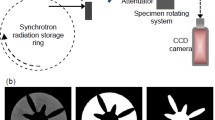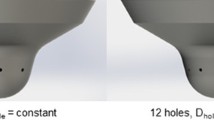Abstract
The geometry of certain parts of diesel injectors is key to the injection, atomization and fuel-air mixing phenomena. Small variations on the geometrical parameters may have a strong influence on the aforementioned processes. Thus, OEMs need to assess their manufacturing tolerances, whereas researchers in the field (both experimentalists and modelers) rely on the accuracy of a certain metrology technique for their studies. In the current paper, an investigation of the capability of different experimental techniques to determine the geometry of a modern diesel fuel injector has been performed. For this purpose, three main elements of the injector have been evaluated: the control volume inlet and outlet orifices, together with the nozzle orifices. While the direct observation of the samples through an optical microscope is only possible for the simplest pieces, both Computed Tomography Scanning and the visualization of silicone molds technique have proven their ability to characterize the most complex internal shapes corresponding to the internal injector elements. Indeed, results indicate that the differences observed among these methodologies for the determination of the control volume inlet orifice diameter and the nozzle orifice dimensions are smaller than the uncertainties related to the experimental techniques, showing that they are both equally accurate. This implies that the choice of a given technique for the particular application of determining the geometry of diesel injectors can be done on the basis of availability, intrusion and costs, rather than on its accuracy.




Similar content being viewed by others
References
Mobasheri R, Peng Z, Mostafa S (2012) Analysis the effect of advanced injection strategies on engine performance and pollutant emissions in a heavy duty DI-diesel engine by CFD modeling. Int J Heat Fluid Flow 33(1):59–69
Dhar A, Agarwal AK (2015) Experimental investigations of the effect of pilot injection on performance, emissions and combustion characteristics of Karanja biodiesel fuelled CRDI engine. Energy Convers Manag 93:357–366
Mohan B, Yang W, Chou SK (2013) Fuel injection strategies for performance improvement and emissions reduction in compression ignition engines—a review. Renew Sust Energ Rev 28(x):664–676
Petrovic V, Bracanovic Z, Grozdanic B, Petrovic S, Sazhin S, Knezevic D (2015) The design of a full flow dilution tunnel with a critical flow venturi for the measurement of diesel engine particulate emission. FME Trans 43(2):99–106
Ilić Z, Rasuo B, Jovanović M, Janković D (2013) Impact of changing quality of air/fuel mixture during flight of a piston engine aircraft with respect to vibration low frequency spectrum. FME Trans 41(1):25–32
Luján JM, Tormos B, Salvador FJ, Galgar K (2009) Comparative analysis of a DI diesel engine fuelled with biodiesel blends during the European MVEG-A cycle: Preliminaru study I. Biomass & Bioenergy 33(6–7):941–947
Postrioti L, Mariani F, Battistoni M (2012) Experimental and numerical momentum flux evaluation of high pressure diesel spray. Fuel 98:149–163
Payri R, Salvador FJ, Gimeno J, Venegas O (2016) A technique to match the refractive index of different diesel fuels with the refractive index of transparent materials to improve the experimental visualization. Exp Tech 40(1):261–269
Duran SP, Porter JM, Parker TE (2015) Ballistic imaging of diesel sprays using a picosecond laser: characterization and demonstration. Appl Opt 54(7):1743
Payri R, Salvador FJ, Gimeno J et al (2011) Flow regime effects on non-cavitating injection nozzles over spray behavior. Int J Heat Fluid Flow 32(1):273–284
Koukouvinis P, Gavaises M, Li J, Wang L (2016) Large Eddy simulation of diesel injector including cavitation effects and correlation to erosion damage. Fuel 175:26–39
Som S, Aggarwal SK (2010) Effects of primary breakup modeling on spray and combustion characteristics of compression ignition engines. Combust Flame 157(6):1179–1193
Salvador FJ, De la Morena J, Martínez-López J, Jaramillo D (2017) Assessment of compressibility effects on internal nozzle flow in diesel injectors at very high injection pressures. Energy Convers Manag 132:221–230
Salvador FJ, Gimeno J, de la Morena J, Martí-Aldaraví P (2012) Using one-dimensional modelling to analyze the influence of the use of biodiesels on the dynamic behaviour of solenoid-operated injectors in common rail systems: Results of the simulation and discussion. Energy Convers Manag 54(1):122–132
Taghavifar H, Khalilarya S, Jafarmadar S, Baghery F (2016) 3-D numerical consideration of nozzle structure on combustion and emission characteristics of DI diesel injector. Appl Math Model 40(19–20):8630–8646
Edelbauer W (2017) Numerical simulation of cavitating injector flow and liquid spray break-up by combination of Eulerian–Eulerian and volume-of-fluid methods. Comput Fluids 144:19–33
Salvador FJ, Carreres M, Jaramillo D, Martínez-López J (2015) Comparison of microsac and VCO diesel injector nozzles in terms of internal nozzle flow characteristics. Energy Convers Manag 103:284–299
Salvador FJ, Martínez-López J, Romero JV, Roselló MD (2013) Study of the influence of the needle eccentricity on the internal flow in diesel injector nozzles by computational fluid dynamics calculations. Int J Comput Math 91, no. June:24–31
Payri R, Salvador FJ, Carreres M, De la Morena J (Apr. 2016) Fuel temperature influence on the performance of a last generation common-rail diesel ballistic injector. Part II: 1D model development, validation and analysis. Energy Convers Manag 114:376–391
Salvador FJ, Hoyas S, Novella R, Martinez-López J (2011) Numerical simulation and extended validation of two-phase compressible flow in diesel injector nozzles. Proc Inst Mech Eng Part-D-J Automob Eng 225(D4):545–563
Satkoski C, Shaver G (2011) Piezoelectric fuel injection: pulse-to-pulse coupling and flow rate estimation. IEEE/ASME Trans Mechatron 16(4):627–642
Ferrari A, Mittica A (2016) Response of different injector typologies to dwell time variations and a hydraulic analysis of closely-coupled and continuous rate shaping injection schedules. Appl Energy 169:899–911
Payri R, Salvador FJ, Gimeno J, De la Morena J (2011) Analysis of diesel spray atomization by means of a near-nozzle field visualization technique. At Sprays 21(9):753–774
Li T, Moon S, Sato K, Yokohata H (Feb. 2017) A comprehensive study on the factors affecting near-nozzle spray dynamics of multi-hole GDI injectors. Fuel 190:292–302
Yu W, Yang W, Zhao F (2017) Investigation of internal nozzle flow, spray and combustion characteristics fueled with diesel, gasoline and wide distillation fuel (WDF) based on a piezoelectric injector and a direct injection compression ignition engine. Appl Therm Eng 114:905–920
Salvador FJ, Carreres M, Crialesi-Esposito M, Plazas AH (2017) Determination of critical operating and geometrical parameters in diesel injectors through one dimensional modelling, design of experiments and an analysis of variance. Proc Inst Mech Eng Part D J Automob Eng
Macian V, Bermúdez V, Payri R, Gimeno J (2003) New technique for determination of internal geometry of a diesel nozzle with the use of silicone methodology. Exp Tech 27, no April:39–43
Piano A, Millo F, Postrioti L, Biscontini G, Cavicchi A, and Pesce FC, (2016) “Numerical and experimental assessment of a solenoid common-rail injector operation with advanced injection strategies,” SAE Int J Engines 9(1)
Mitroglou N, Lorenzi M, Santini M, Gavaises M (2016) Application of X-ray micro-computed tomography on high-speed cavitating diesel fuel flows. Exp Fluids 57(11):1–14
Kastengren AL, Tilocco FZ, Powell CF, Manin J, Pickett LM, Payri R, Bazyn T (2012) Engine combustion network (ECN): measurements of nozzle geometry and hydraulic behavior. At Sprays 22(12):1011–1052
Otsu N (1979) A threshold selection method from gray-level histograms. IEEE Trans Syst Man Cybern 9(1):62–66
Acknowledgements
This work was partly sponsored by "Ministerio de Econom ía y Competitividad", of the Spanish Government, in the frame of the Project "Estudio de la interacción chorro-pared en condiciones realistas de motor", Reference TRA2015-67679-c2-1-R.
Author information
Authors and Affiliations
Corresponding author
Rights and permissions
About this article
Cite this article
Salvador, F.J., Gimeno, J., De la Morena, J. et al. Comparison of Different Techniques for Characterizing the Diesel Injector Internal Dimensions. Exp Tech 42, 467–472 (2018). https://doi.org/10.1007/s40799-018-0246-1
Received:
Accepted:
Published:
Issue Date:
DOI: https://doi.org/10.1007/s40799-018-0246-1




